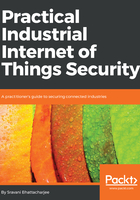
上QQ阅读APP看书,第一时间看更新
ICS components and data networks
An overview of the various ICS/SCADA control components is provided here:
- Control server: The control server hosts supervisory control software (for DCS and PLC), which communicates with subordinate control devices over an ICS network.
- Master terminal unit (MTU): MTU or the SCADA server acts as the master in a SCADA system, while remote terminal units and PLC devices, which are located at remote field sites, act as slaves.
- Remote telemetry unit (RTU): The RTU supports data acquisition and control in SCADA remote stations. As field devices, RTUs are equipped with both wired and wireless (radio) interfaces.
- Intelligent electronic devices (IED): These are smart sensors/actuators containing the intelligence required to acquire data, communicate to other devices, and perform local processing and control. An IED could combine an analog input sensor, analog output, low-level control capabilities, a communication system, and program memory in one device.
- Human-machine interface (HMI): The HMI is usually stationed in centralized control rooms, and includes the software and hardware that allow human operators to monitor the state of a process under control, modify control settings, configure set points and control algorithms, and manually override automatic control operations in the event of an emergency. The HMI displays process status information and reports to supervisory personnel, who usually have internet access.
- Data historian and IO server: The data historian is a centralized database for logging all processed information within an ICS and supports various planning and report generation functions, while the IO server collects and buffers information from PLCs, RTUs, and IEDs.